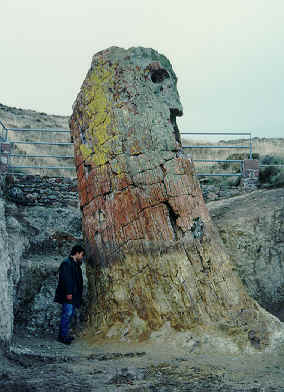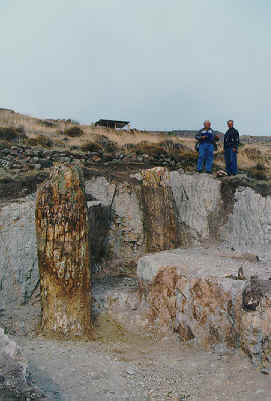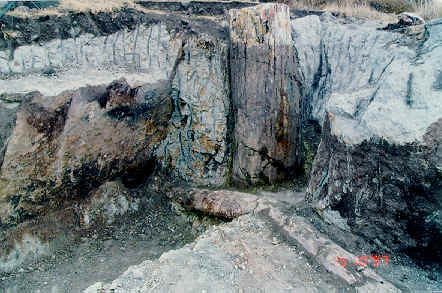EXCAVATIONS
IN THE PETRIFIED FOREST
|
|
The
standing trunk of a pertified tree with a height of 7.02 m and a perimeter of
8.58 m. This is the largest known petrified trunk up to today, not only on
the island of Lesvos but almost certainly in Europe. This lower trunk
preserved in excellent condition is one of the largest plant fossils in the
world. According to Professor E.Velitzelos, the artefact pertains to the
species Taxodioxylon gypsaceum. |
Finds which have come to light
following excavations conducted by the Museum of Natural History of the
Petrified Forest of Lesvos have proven to be of considerable scientific value. It
is expected that these finds, officially announced at an international
conference this May, will stimulate lively interest within the scientific
community and among the numerous visitors who come to the Petrified Forest each
year to marvel this truly unique natural monument.
This year for the first time the
Museum is carrying out excavations in the area of the Petrified Forest in
cooperation with the Lesvos Directorate of Forests with funding provided by the
Ministry of Culture. The purpose of this endeavour is to uncover parts of the
Petrified Forest buried under large masses of volcanic rock and to collect data
regarding the composition of the fossilised ecosystem. Finds are to be
exhibited in their natural environment within the Petrified Forest Park as well
as in the museum now under construction. Excavations are being conducted under
the direction of Museum Director Dr N.Zouros in cooperation with Professor of
Palaeobotany - Palaentology of the University of Athens, E.Velitzelos.
The principle excavation area is
located within the Petrified Forest Park at «Bali Alonia», site of the largest
concentration of petrified trees.
To date excavations have progressed
considerably revealing a large number of fossilised plants of particular
scientific importance. In the course of activities, five excavation pits were
opened revealing the followings:
First excavation site
The
standing trunk of a pertified tree with a height of 7.02 m and a perimeter of
8.58 m. This is the largest known petrified trunk up to today, not only on the
island of Lesvos but almost certainly in Europe. This lower trunk preserved in
excellent condition is one of the largest plant fossils in the world. According
to Professor E.Velitzelos, the artefact pertains to the species Taxodioxylon
gypsaceum.
|
|
Two standing petrified conifer
trunks less than 2.0 m apart most probably pertaining to the Protopinaceae
family. The heights of the trunks are 2.70 m and 2.22 m, having perimeters of
2.90 m and 2.26 m respectively. The external structure and internal
characteristics of the wood are excellently preserved with the concentric
annual rings evident in both cases. In all likehood, these trunks pertain to
the new coniferous species Pinoxylon paradoxum SUSS & VELITZELOS, first
found in Lesvos and abundant throughout the broader region of the Petrified
Forest of Lesvos. |
Second excavation site
Two
standing petrified conifer trunks less than 2.0 m apart most probably
pertaining to the Protopinaceae family. The heights of the trunks are 2.70 m
and 2.22 m, having perimeters of 2.90 m and 2.26 m respectively. The external
structure and internal characteristics of the wood are excellently preserved
with the concentric annual rings evident in both cases. In all likehood, these
trunks pertain to the new coniferous species Pinoxylon paradoxum SUSS &
VELITZELOS, first found in Lesvos and abundant throughout the broader region of
the Petrified Forest of Lesvos.
Apart
from the above mentioned, excavations also brought to light a fallen trunk
probably of the species Taxodioxylon gypsaceum. Excavation of this particular
trunk is still in progress.
Third excavation site
A
standing petrified tree trunk, the upper section of which was revealed as a
result of the natural erosion of volcanic rock. The tree’s root system has been
uncovered in very good condition. The height of the artefact is 2.15 m and
perimeter 2.18m. Besides this is a falen petrified trunk, a large portion of
which was also uncovered as a result of the natural erosion of volcanic rock. The
restored trunk using the existing fragments and pieces measures 4m in length. Excavation
of the particular trunk is still in progress.
Forth excavation site
A
standing petrified trunk with impressive shades of purple, clear annual rings
and excellently preserved morphological characteristics of the wood’s
structure. According to speculations this tree pertains to the protopinaceae
family, more specifically of the species Pinoxylon paradoxum SUSS &
VELITZELOS. The height of the trunk is 2.05m and its perimeter 2.56m.
Fifth excavation site
A
standing petrified trunk twisted in a characteristic fashion most probably
because of the pressure exerted by the volcanic material that covered the flora
and finally led to petrification. This trunk is of a diameter of 50 cm and
height of 1.2 m. Excavation has not yet been completed.
In the course of excavations, parts
of plants were uncovered (fruit, leaves, branches, roots) which have remained
well preserved until today, protected by the volcanic material in which they
are embedded. Nonetheless, exposure to the elements of the erosion, the danger
of theft and destruction pose a true threat for these fragile artefacts. Finds
of this nature are to be exhibited in the Museum of Natural history of the
Petrified Forest.
Initial Conclusions
The importance of the finds is
based on the fact that they reveal with great certainty that the area of
excavation is located at the highest point of mixed coniferous forest. The
majority of trees in the forest are of the species Taxodioxylon gypsaceum
(GOPPERT) KRAUSEL. This species is a ancestor of the present day species
Sequioa semprevirens. Contemporain trees of these species, classified as
members of the Protopinaceae family, reach a height of 120-130m. The majority
pertains to the new coniferous species Pinoxylon paradoxum SUSS &
VELITZELOS first found on Lesvos and ancestor of the present day pine-tre. The
olotipos of the species exists within the Petrified Forest Park.
Representatives of poplar, bay,
cinnamon, plane, oak, beech, palm, sklithro, maple and cypress-tree species
have also been found in the Petrified Forest.
The composition of the petrified flora
demonstrates that the Petrified Forest of Lesvos developed in a subtropical
climate that abruptly changed to a warm continental climate. The flora of the
region was that characteristic one of subtropical zones of Southeast Asia and
America.
The abundance of preserved standing
trunks with their root systems intact and in a stage of full development,
attests to the fact that the trees were petrified and are still located in
their original position. In other words, this is an indigenous petrified
forest. Aside from the petrified trunks, fossilised roots, fruit, leaves, seeds
etc. are preserved in excellent condition, embedded in and protected by
volcanic rock.
The geological history of the
Aegean basin of the last 20 million years is imprinted upon the petrified
forest. This provides us with unique information not only regarding the flora
but ecological conditions, the climate and its fluctuations, volcanic activity
and the tectonic movement which resultd in the geological structure and
formation of the area.
Our medium term aims are to conduct
systematic excavations to uncover the numerous petrified trunks that are
nowdays covered by volcanic rock. There are indications that a particularly
large number of petrified trunks are from coniferous trees of the species
Pinoxylon paradoxum, Taxodioxylon gypsaceum and Cunnihamia meiocenica which
made up the subtropical forest which was developed in the Aegean region 20
million years ago. At lower relief points, the coniferous tree forest is mixed
with the deciduous forest. An ecosystem comparable to that which existed in the
Petrified Forest, the subject of research conducted under the auspices of the
Museum, is that of coniferous forests found today in North America.
|
|
|
Our
medium term aims are to conduct systematic excavations to uncover the
numerous petrified trunks that are nowdays covered by volcanic rock. |
|
|
|
The
excavation finds provide us with unique information not only regarding the
flora but ecological conditions such as tectonic movements which
resultd in the geological structure and formation of the area (see twisted
laying tree trunk). |



